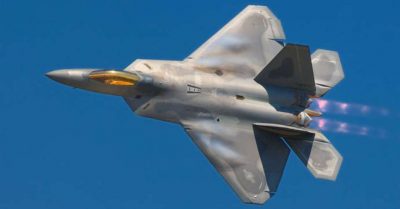US and South Korea Announce Plans for Massive Air Force Exercise Aimed at North Korea
The early December drill comes as tensions continue to rise over North Korea's nuclear program and Trump's persistent antagonization of the nation's leader

Featured image: A Lockheed Martin F-22A Raptor fighter takes flight at a Joint Services Open House airshow at Andrews Air Force Base. (Photo: Rob Shenk/Flickr/cc)
The U.S. and South Korea announced Friday they will conduct a massive air force exercise over the Korean Peninsula next month as a notable show of force targeting North Korea—despite warnings that the Trump administration’s decision earlier this week to add North Korea to the United States’ list of state sponsors of terrorism could further provoke the isolated country.
Six F-22 Raptor stealth fighters—which are among the world’s most advanced warplanes—will be sent to South Korea for the drill, a U.S. Air Force spokesman told AFP, which reports:
The massive five-day annual exercise comes as Washington pushes what President Donald Trump has called a “maximum pressure campaign” against Pyongyang over its nuclear program.
The exercise, named Vigilant Ace, starts on December 4 with 12,000 U.S. personnel and an unspecified number of South Korean airmen flying more than 230 aircraft at eight U.S. and South Korean military bases.
Reuters reports that U.S. Marine Corps and Navy troops will also participate in the exercise.
Although the drill is conducted annually, it comes as U.S. President Donald Trump continues to antagonize North Korean leader Kim Jong-un on the world stage.
As Common Dreams reported this week, after Trump designated North Korea as a state sponsor of terrorism on Monday, the North Korean Central News Agency called the decision a “serious provocation,” and warned that “our army and people are full of rage and anger toward the heinous gangsters” who made the decision.
Concerns about the escalating conflict, and the Trump administration’s vocal opposition to engaging in diplomatic discussions with North Korea, continue to rise in the U.S. as well as among North Korea’s neighbors, particularly South Korea. When Trump visited Asia earlier this month, South Koreans greeted him with massive protests—denouncing him as a “war-threatening, weapons salesman”—while Pyongyang claimed the president “begged for war” during his trip.
This work is licensed under a Creative Commons Attribution-Share Alike 3.0 License

